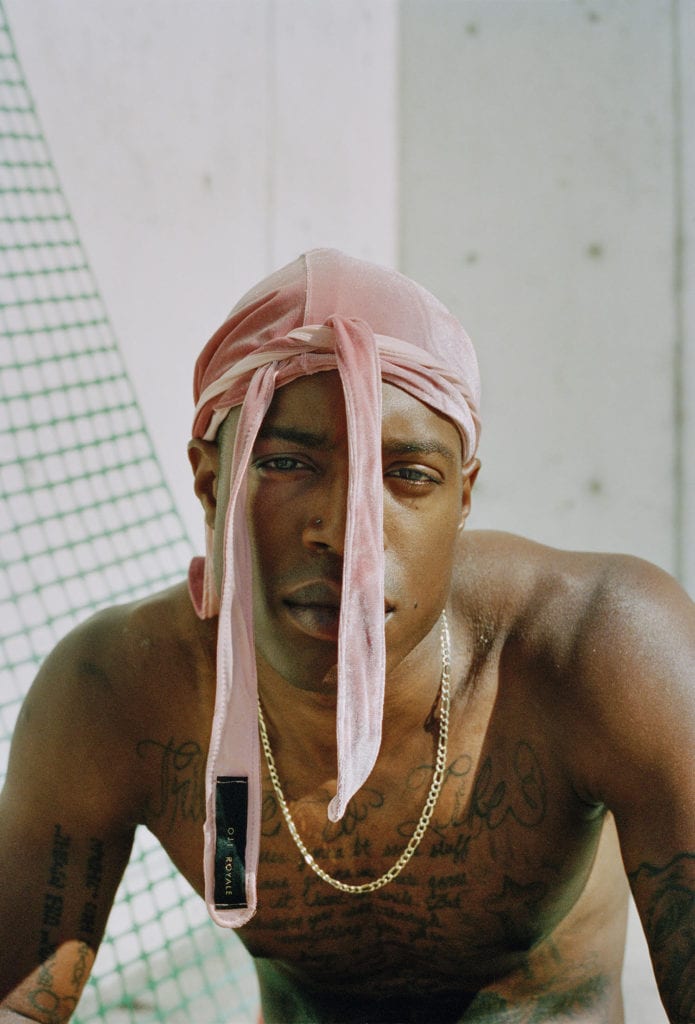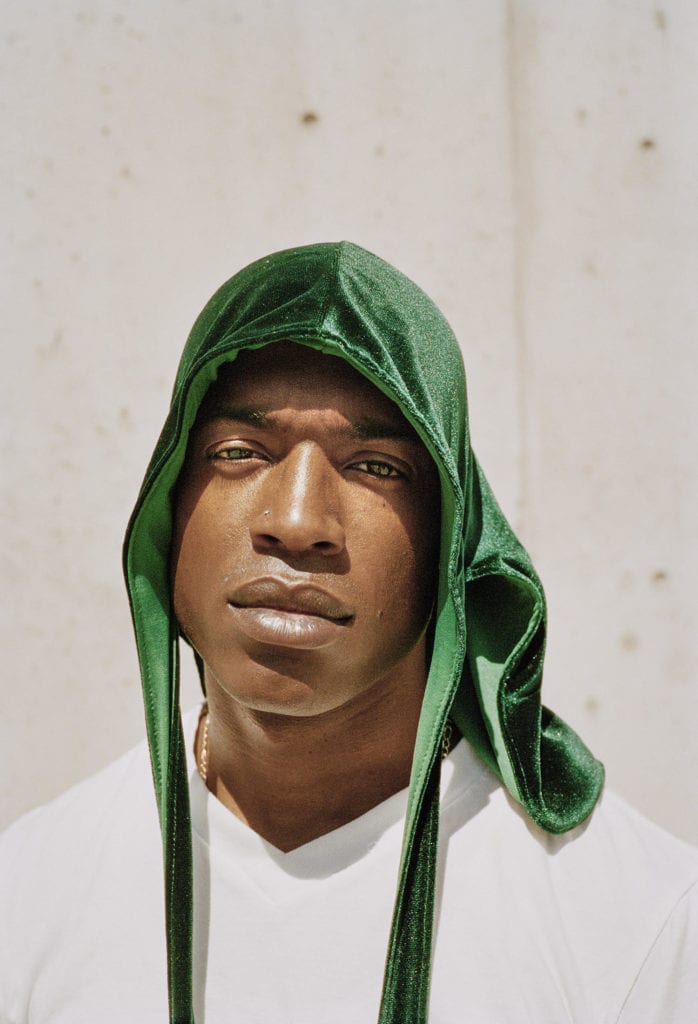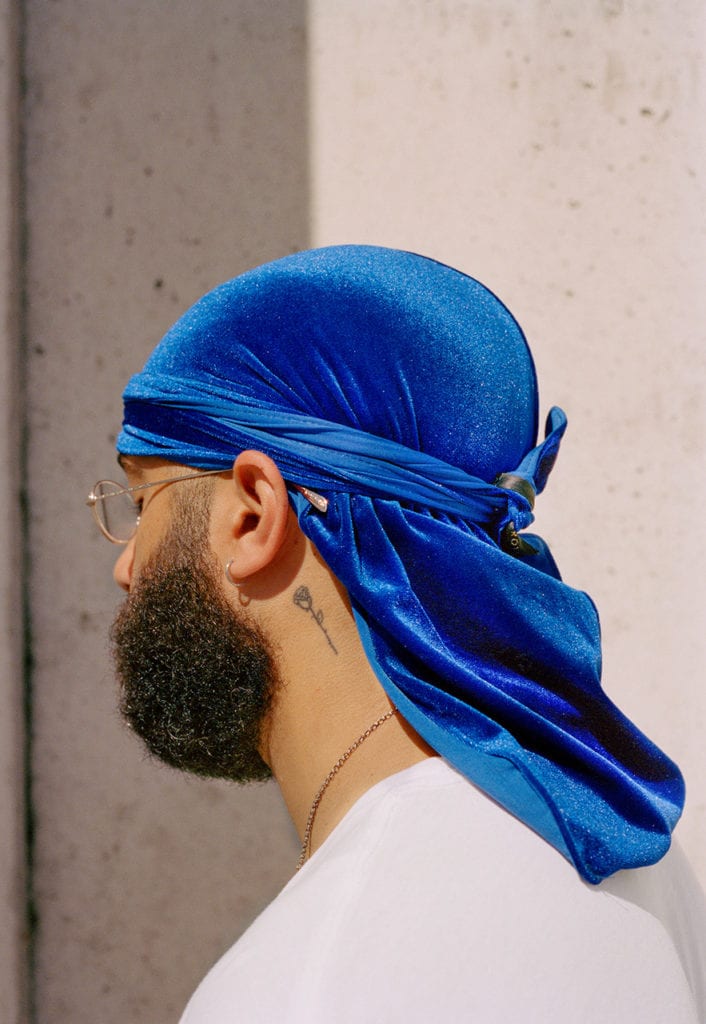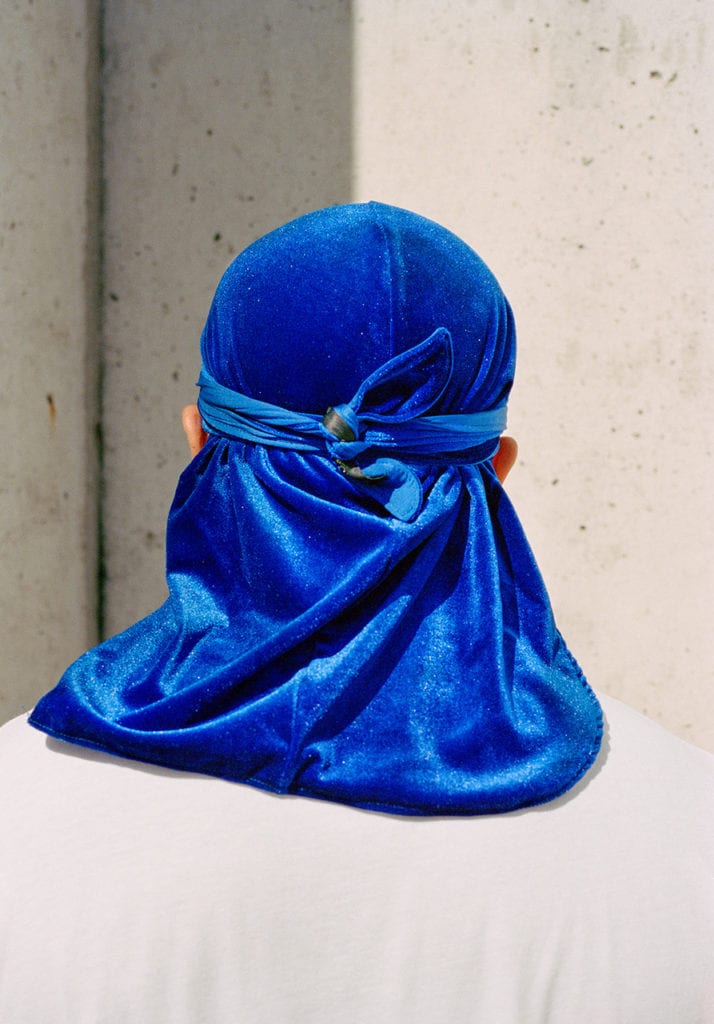The first time I saw Adrian Octavius Walker’s work was at a photography exhibition titled, Green Book at a small photo gallery in San Francisco the summer of 2018. In a room full of photos, his work—three massive, crystal-clear film portraits of Black men in durags—effortlessly commanded. At the time, I did not know Adrian very well—we were more acquaintances than friends—but the photos revealed an openness so raw and intimate, that I somehow felt closer to him when I finally turned away.
Creating these kinds of relationships through his photography, I later learned, is a massive part of the St. Louis, Missouri native’s practice. And when thinking about his accomplishments in the last few years, especially around his iconic “We Matter” series, it is clear how his work has done just that—building connections and community through every one of his artistic endeavors.
From organizing live events in his hometown to showing at the National Portrait Gallery as a finalist in the triennial Outwin competition, Adrian is establishing himself as a true force in the photo world with his intense, socially-oriented work. But for him, that’s only the beginning.

When did you start taking photos?
My freshman year of college. I remember getting into Photo 1—I did not have a camera, so I had to drop the class, but I kept practicing with a friend’s camera.
What inspired you to first pick up the camera?
Just being curious. Growing up in the neighborhood that I grew up in, there was always a lot of activity going on, but I did not even think about documentation or anything like it. I was just a kid in the neighborhood.
I also picked up sociology in school, which also had a big impact when it came to my photo career because I always liked being really social. And for me, taking photos is really not about the pictures that I am taking. It’s about the relationships I’m building. So that really inspired me to photograph the person, or whatever thing that is around me, and to talk about it later.
It was both your documentation of what’s happening and the relationship that you build between you and your subject.
Correct. People, places, and things, you know. Most obviously, people. There are a lot of interesting looking people in the world, but that’s not the thing that attracts me the most. It’s more so being able to bond with the person and establish a relationship. That’s honestly how I feel like my photos come out—kind of like when we photographed together. We had a relationship already, but you know, you were comfortable. I was comfortable. And things just fell into place. That’s all from relationship-building.
Could you tell me more about where you grew up? It sounds like it was a busy place—what was that like?
I wouldn’t necessarily say it was busy. I am from St. Louis, Missouri, so things are rather slow. I grew up in North City St. Louis, around a lot of gang activity, police corruption, dog fights, all that. I do not come from a judgmental place, but I never understood why certain things happened within my neighborhood.
I was like the typical kid—I would go outside, catch bugs with friends. I also had a lot of cool things—I guess you could say that I was a privileged kid within my neighborhood, because I had a telescope, microscope, all these things. I thought I was going to be some sort of scientist growing up. I did not think about cameras, but in my neighborhood there were a lot of things going on, so I was interested in learning more about those things and those people, and why they chose to do the things that they did. I was never attracted to pursuing those things because I knew what the outcome would be; I did not really take a lot of chances growing up. I really tried to stay in my lane, but still learn about everybody else around me.

As a journalist, I can see how that would become an influence for wanting to document. Do you also have other artistic influences or photographers you’re inspired by?
I mean, now I do. But I wasn’t necessarily a big photography nerd when getting into photography. I was mostly inspired by classmates and people around me. I did come across Gordon Parks—well, I didn’t even know it was Gordon Parks; I learned down the line that it was his photos. What also inspired me was basically looking at images of things that I would want to document. I would type into my computer “Black people in Black neighborhoods” or “Black neighborhoods United States,” then get these visual references, and take that within my own practice.
But right now, as far as artistic influences, you got Arthur Jafa, Carrie Mae Weems, LaToya Ruby Frazier. A lot of my influences are women—Black women photographers. And then my own peers, people that I’m friends with. Joonbug. Kameron Richie. I don’t really want to name drop too many people, because there are so many people I’m inspired by. But once I started working at VSCO—an art-technology company and creative photo platform in Oakland, CA—I met a lot of people who introduced me to a different outlook on photography and what it is. Being around these individuals really inspired me. I can name drop two of them: Kendal Kulley and John Slye. Today, I still don’t have a definition of photography. I don’t have a definition of art. It can be defined as so many different things. Everything looks different by somebody else, you know what I’m saying? Nobody sees the same thing. That’s why photography is really amazing to me.
I think it is really special that you draw so much inspiration from people around you. Creatives and artists can sometimes get into these competitive silos and not want to engage with the community. I feel like that’s a through-line with your work—you are always wanting to put on other people and grow with them.
That’s the thing. I am so into sharing knowledge and talking to other creatives about things. We don’t necessarily have to talk about photography the entire time, but breaking bread with other artists and working with them, no matter what field, is really inspiring to me. Especially painters and sculptural artists. It’s two things that I really want to get good at. It’s crazy to get comments like, “I thought that was a painting” for my photos—I’m super flattered. I’m like, “damn, I wish.” That is why it is really easy for me to be so open and willing to chat with these folks.

Your spirit really shines through that—your humility, your eagerness to learn and keep growing.
I want people to know, “it ain’t no front, man.” I really do ‘eff with a lot of folks. I have always been like that. Music, fashion, art—I can find something from all over the art world.
Are there certain stories you try to tell with your work?
Being able to embody the stories of my own culture is something I’m really into. Being a Black man in America. Growing up in not-the-best neighborhood. Why not tell the stories that I know, that are a product of my environment? It’s easier for me to be able to tell these stories—and also not allow other people to write our stories and write our histories.
Even if I don’t come from a certain place, talking to certain individuals and groups they come from helps me tell their stories in a visual way. So yes, I do try to tell a story when it comes down to my works, which is why I have been sitting on a lot of work too, because I want to go back and look at it.
You want to see how you want to frame it?
Yeah, to see if anything’s there. To have some second opinions, talk to whomever I photographed, to get a feel from them. How did things work out? How did I make them feel? To be able to share those references and talk to folks about their experience.

I love how collaborative your process is. The open dialogue between you and your subjects continue even after the shoot. Which groups are you drawn to the most?
I have a series called “We Matter” that is really, really out there. It’s a series of Black men wearing durags, and it’s really a popular thing right now in the photo world amongst Black men, Black women, Black culture. Within these photographs, I was seeing how we, as Black men, are always looked at as a threat due to the fact that we choose to wear this particular hairpiece on our heads—and the only thing we are doing is protecting our hair. Within these images, you know, it is one of those things where I got the film back, and I am looking at these photos, and they’re speaking to me. It is almost like my photos bring out the best within me, as a person. Things I didn’t even know I had.
“We Matter” was, and is, so powerful. For one, its meaning is extremely strong, but also the vividness of the imagery—I feel like it’s out of this world. The show went from its opening at San Francisco’s Southern Exposure to the Smithsonian. What has that journey been like?
I mean, the fact that it’s in the National Portrait Gallery at the Smithsonian is one of the biggest honors I have ever had in my photo career. I am still processing this, but people are seeing my work every day now from all over the world. It has really shaking me up, in the best way. For instance, there was a gala going on at the National Portrait Gallery, and I met Amy Sherald, the Black woman painter who painted the portrait of Michelle Obama that is currently hanging there., that night. To make a long story short, Michelle Obama probably saw my work, and that is crazy as hell.
How does photography as a medium help you communicate social messages?
Well, going back to what I know best and being able to tell the story of those who are actually living an experience… it’s almost like rewriting our history, too, in a way, but also telling a new history. So, by being able to work with individuals who have or are going through certain things as a unit, I am able to tell these stories through them, because they actually lived the experience. If you have not lived the experience, how could you tell the story of something or somebody else?
It’s like giving them the platform through your work.
Right. I’m just taking a photo. They are doing all the work. I don’t really want to give myself all the credit.
I feel like I don’t come across a lot of photographers who approach it this way.
I would be lying to you if I said it was all the time. Sometimes it’s, “yo, you got a dope ass outfit on. I want to take photos of you.” Alternatively, I am shooting a homie this weekend that I have been wanting to photograph for a while, Daghe. He is an amazing DJ out of Oakland, California. We have not worked together yet, but now we are actually able to work and break bread with each other. I admire the hell out of Daghe and his hustle as a musician—it is one of those things where I feel like this is going be something. That is another thing that I get out of my work—feeling. It is something I have to feel. And if I feel it, it is almost like I can see it. Before even photographing Daghe, I can feel the energy that it is going be good, which makes me more excited about whatever we are going to produce.
What do you have planned next?
I am one of the featured artists in this show called Don’t Shoot in San Francisco at the Museum of African Diaspora. That was last December. I have a solo show coming up in Oakland, California on March 14, 2020 with “We Matter.” And honestly, I am looking forward to making more work for 2020, just taking my time to conceptualize and come up with some really amazing things.

About the artist
Adrian Octavius Walker is a mixed-media artist based in Chicago, IL by way of St. Louis Missouri.
His work is inspired by the Black body, dynamics of the Black family and archival work related to the African American experience and the untold stories they share. Working in both film and digital-format photography, Walker creates penetrating portraits influenced by his deep awareness of the nuances that pervade the human experience. His greatest milestone to date is being one of the prize-winning artists in The Outwin 2019: American Portraiture Today Competition currently on display at the National Portrait Gallery Smithsonian in Washington, D.C. Walker is currently represented by pt.2 Gallery Oakland, Ca. You can find him curating artist talks and creating dynamic installation work. He enjoys collecting photobooks, some commercial photography, and discovering artists on the web. Give him a shout @aoctaviusW

